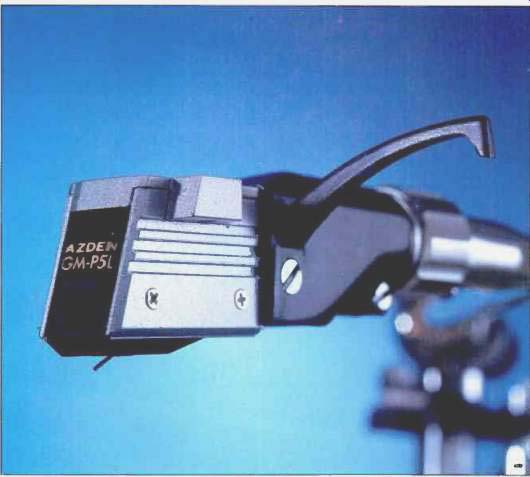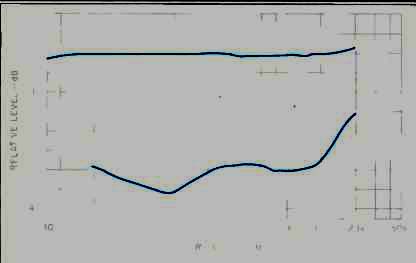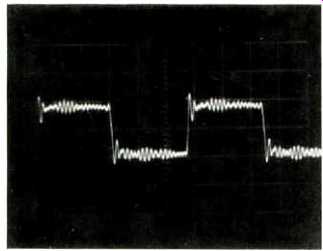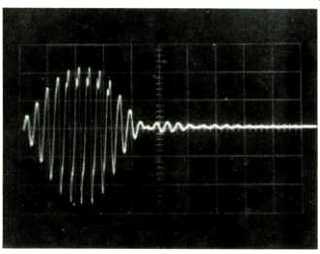
Manufacturer's Specifications:
Type: Moving coil.
Stylus: Nude line-contact.
Cantilever: Boron tube.
Frequency Response: 10 Hz to 60 kHz (supplied with calibration curve, 20 Hz to 20 kHz).
Separation: 30 dB at 1 kHz.
Vertical Tracking Force: 1.25 grams, ± 0.25 gram.
Dynamic Compliance: 17 x 10^-6 cm/dyne.
Output: 0.2 mV at 5 cm/S at 1 kHz.
Channel Balance: Within 0.5 dB at 1 kHz.
D.C. Resistance: 10 ohms.
Impedance: 10 ohms at 1 kHz.
Load Resistance: 40 ohms.
Load Capacitance: 100 to 300 pF.
Cartridge Mass: 5.9 grams; 8.8 grams with P-mount adaptor for standard arms.
Vertical Tracking Angle: 20°.
Price: $250; replacement stylus, $125.
Company Address: 147 New Hyde Park Rd., Franklin Square, N.Y. 11010.
The GM-P5L is at the top of the line of cartridges offered by Azden. It uses a nude, 0.1-mm-square, line-contact stylus, mounted in a hollow boron-tube cantilever, which is supported by a one-point suspension system. A frequency response extending into the ultrasonic region is claimed, and the one-point support of the cantilever is said to assure excellent image localization. The magnetic circuit is energized by a samarium-cobalt magnet, a material that has a high energy level. The cartridge design uses a cross shaped armature with a hole through the pole piece for the cantilever. The armature is surrounded with an elastomer, and I was able to observe its entire connection to the cartridge body using a 100 x microscope. The stylus appeared accurately mounted to the cantilever, was well polished, and seemed to be properly shaped. The cartridge housing is made of die-cast aluminum. A P-mount design, the GM-P5L is supplied with an adaptor that allows its use in standard arms. It comes in a two-piece plastic container.
Measurements
After measuring an inductance of 0.5 mH and a resistance of 10.5 ohms, I mounted the GM-P5L in a Grace G747 tonearm on a Denon DP-6000 turntable. The tonearm and cartridge were aligned with the aid of a Telarc Omni Disc. Measurements were made on both channels to assure accuracy, but only the left channel is reported here unless there was significant variation. During the test period the room temperature was 72° F, ± 2°, and the relative humidity ranged from 40 to 60%. The following records were used in making the measurements: CBS STR-100 and STR-112, Deutsches HiFi No. 2, Ortofon 0002, and Shure Brothers TTR-103, TTR-110, TTR-115, and TTR-117.
The tracking force found to be optimum was 1.5 grams, and the optimum anti-skating force was 1.7 grams; settings were made accordingly. For testing, a load resistance of 40 ohms and a load capacitance of 200 pF were used. For some measurements, the output was taken from a Technics SH-305MC transformer which was set for an input resistance of 30 ohms.
The low-frequency arm/cartridge resonance resulted in a 7-dB response rise at a frequency of 9 Hz. The combination of a low 7-dB rise and a desirable resonant frequency allowed the cartridge to track warped records with little problem.
Using the CBS STR-100 test record, the GM-P5L's frequency response (see Fig. 1) was found to be within 3 dB from 40 Hz to 20 kHz. Using the same record, channel separation at midrange frequencies was around 30 dB, reaching a high of 35 dB at 500 Hz. Separation over the entire audio spectrum was unusually high, and illustrates the kind of progress that is being made in cartridge design and construction.
Figure 2 shows the square-wave response obtained with the CBS STR-112 test record. An expanded 'scope trace revealed the rise-time to be 10 µS when the cartridge was connected to the Technics transformer. The single cycle of overshoot and undershoot, followed by low-level ringing, indicates a relatively undamped stylus resonance taking place at about 35 kHz, which is also present on the record as an artifact. The extended high-frequency response of the cartridge is evident from the magnitude of the response in the horizontal parts of the trace.
Figure 3 illustrates the GM-P5L's tracking on the highest level of the 10.8-kHz pulsed sine wave on Shure's TTR-103 test record. It is recorded at a peak velocity of 30 cm/S. Although there is visible distortion present, there is little evidence that the cartridge produced compression or objectionable resonances.
Static vertical compliance was 41 x 10^-6 cm/dyne. The cartridge's dynamic vertical compliance was found to be 10.2 x 10^-6 cm/dyne, and its dynamic lateral compliance measured 12.8 x 10^-6 cm/dyne. The cartridge output was 56 µV/cm/S for the left channel and 52 µV/cm/S for the right.
This gives a channel imbalance of 0.6 dB and an output about 3 dB greater than the 200 µV specified.
Using the 3.54-cm/S, 45°, 1-kHz signals from the CBS STR-100 test record, the Azden's total harmonic distortion was found to be 1.5%. IM distortion, using the CBS STR-112 (400/4,000 Hz, 4-to-1), was: Lateral (+9 dB), 0.8% for the left channel, 0.9% for the right; vertical (+6 dB), 4% for the left channel, 3.5% for the right.

Fig. 1--Frequency response and separation, using CBS STR-100, of Azden GM-P5L
cartridge in Grace G-747 tonearm.

Fig. 2--Cartridge output from 1-kHz square wave, CBS STR-112 test record.

Fig. 3--Output from 10.8-kHz pulse test, at 30 cm/S, Shure TTR-103 test
record.
The Azden GM-P5L was able to track most of my test records with no distortion visible on my 'scope or audible. It tracked the highest vertical 300-Hz band of the Deutsches HiFi No. 2 test record, which is recorded at 55.4 microns (0.00554 cm) at 10.32 cm/S and 5.86 dB. It was able to track the second-highest horizontal level, which is recorded at 95 microns (0.0095 cm) at 17.90 cm/S and 10.33 dB. Using Shure's TTR-103, it could track band 7 of side one, which is composed of 1,000and 1,500-Hz signals of equal amplitude, recorded at a peak velocity of 31.5 cm/S. It could do a fair job of tracking band 8 (40 cm/S) of this record if the tracking force was set at 1.75 grams, which is about 17% above the recommended maximum value. There are five levels on Shure's Era IV Obstacle Course, with level five being the hardest to track. The cartridge was able to pass all of the individual instrument tests, level 3 of the harp-and flute test, and level 5 of the bell-and-flute test. Shure's Era V Obstacle Course has six bands of a complex signal composed of 200 Hz, 2.1 kHz, and 17 kHz. This cartridge was able to track four of those bands without any audible mis tracking or visible waveform distortion on the 'scope, and tracked levels five and six with a slight amount of 'scope distortion but no audible distortion. An X/Y plot of monophonic signals from several test records revealed good linearity and phasing between channels.
Use and Listening Tests
The Azden was used to audition several digitally mastered and direct-to-disc recordings, using the same Denon turntable and Grace tonearm which were employed for the measurements. For the listening tests, in addition to the Delos, Mobile Fidelity Sound Lab, and superb Opus records I have used in previous reviews, I employed a recent addition to my collection: The Pro-Use Series, put out by Toshiba-EMI Ltd. These records were made by the direct-cut method and have very little surface noise. Literature accompanying them contains technical information such as microphone placement and other recording data.
The Toshiba-EMI records used were Super Strings, Tokyo String Ensemble, Kouichi Sugiyama, conductor (LF-95010); Sgt. Pepper's Lonely Hearts Club Band, Jun Fukamachi (LF95014), and 30 Years in 30 Minutes, Eiji Kitamura & All Stars (LF-95012). Other records used include: Beethoven: Piano Sonata No. 23 in F Minor, Op. 57, "Appassionata," Ikuyo Kamiya, pianist (RCA RDC-4/JRL 1-1105); Ravel: String Quartet in F Major, Bartók: String Quartet No. 3, Sequoia String Quartet (Delos DMS 3004); Stravinsky: Firebird Suite, Debussy: Afternoon of a Faun, Los Angeles Philharmonic Orchestra, Erich Leinsdorf, conductor (Sheffield Lab 24); Chopin: Sonata No. 3 in B Minor, Op. 58, Steven Gordon, pianist (Reference Recordings RR-5); and Ragtime Concert, Nexus (Umbrella UMB DD-2). As the measurements would suggest, the cartridge performed well during the listening tests, producing a sound that could be characterized as clean and unrestrained. For some reason, possibly because the line-contact stylus was tracing a lot of virgin groove wall, the GM-P5L played many records with less surface noise than did most of my other cartridges. I was especially impressed by the clarity with which it reproduced piano solos and percussive sounds.
The GM-P5L's unusually good separation was evident when listening to some of the newer records that use the simpler miking techniques in vogue today. Bass was solid, the midrange clear and natural, and the highs unrestrained. The cartridge was able to track all the commercial discs I tried it with, and most of my test pressings of musical material, with no audible distortion. As mentioned earlier, the well-behaved resonance of this cartridge with the Grace tonearm allows this combination to track records that some of my other combinations have not been able to handle.
This is a state-of-the-art cartridge. Azden has produced an excellent moving-coil cartridge that is worthy of serious consideration by those who are in the market for a new one, and who do not mind the additional considerations that a moving-coil unit entails.
-George Shellenberger
(Source: Audio magazine, Jan. 1987)
Also see:
B & O MMC 20CL Phono Cartridge (Mar. 1980)
ADC Model LMF-2 Tonearm & ZLM Phono Cartridge (Jan. 1979)
Audio-Technica AT160ML Cartridge (Sept. 1984)
Bang & Olufsen Beogram CD X Compact Disc Player (Mar. 1986)
= = = =